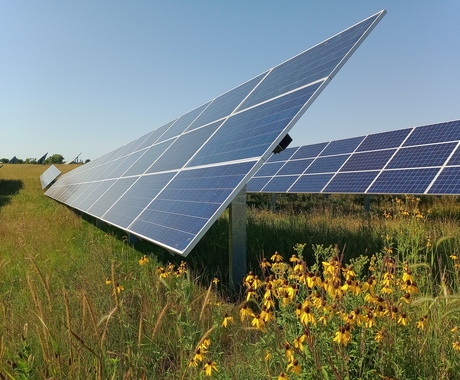Cora Hoffer, policy associate, [email protected] or 507.513.8545; and Rhea Landholm, communications manager, [email protected] or 402.687.2100 ext. 1025
New resources from Center for Rural Affairs identify opportunities and challenges in clean energy transition
MINNESOTA—Minnesota has potential to take advantage of the steady growth of the solar industry. However, the state must first address how to improve and expand its transmission system to ensure adequate capacity for connecting new solar energy projects, according to the Center for Rural Affairs.
New fact sheets from the Center highlight opportunities to leverage policy, make investments in infrastructure, and break down barriers to growth in the industry.
According to the U.S. Energy Information Administration, the solar industry grew by 25.1% nationally between 2021 and 2022. Additionally, in 2022, Minnesota ranked 17th among U.S. states and territories in solar power production, with about 90% coming from utility-scale installations.
Despite that, Cora Hoffer, policy associate with the Center, said the industry’s continued growth hinges on investments in transmission infrastructure to alleviate inadequate capacity problems on the electric grid and address permitting process delays.
“Limited capacity on the electric grid creates constrictions, which slows the pace of project installations and makes it difficult to connect new renewable energy projects,” Hoffer said. “Without crucial investments to create a robust transmission system, it will be difficult for Minnesota to tap into the economic and environmental benefits that the solar energy industry offers.”
In 2023, the U.S. Department of Energy provided $464 million to help build a series of high-voltage transmission lines that will span seven states, including Minnesota. This project will enable the connection of about 50 gigawatts of renewable energy and create more than 56,000 jobs for wind, solar, hybrid, and battery storage projects locally in Minnesota, western Wisconsin, and North Dakota.
“This historic investment will allow states to leverage federal clean energy funding to strengthen our electrical grid,” said Hoffer. “Developing new transmission lines creates jobs and enables future renewable energy projects, which, when coupled with Minnesota’s 2040 clean electricity law, encourages solar installations that will aid in the clean energy transition.”
To read and download a copy of the Center’s fact sheet, “Opportunities and Challenges: Transmission in Minnesota,” visit cfra.org/TransmissioninMinnesota.
To read and download a copy of the Center’s fact sheet “Solar Energy Presents Opportunity for Minnesota,” visit cfra.org/MN-solar-opportunities.



